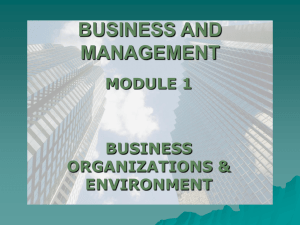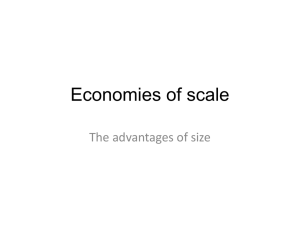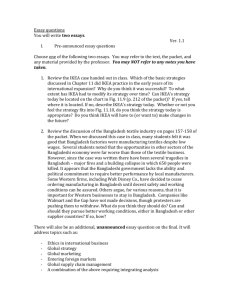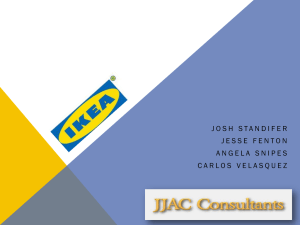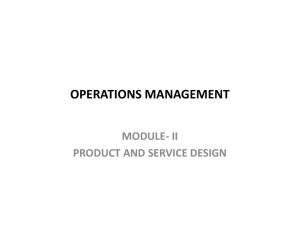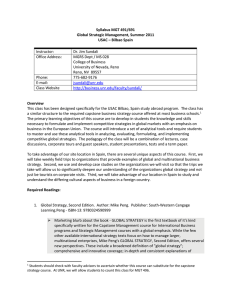course outline stoettinger
advertisement
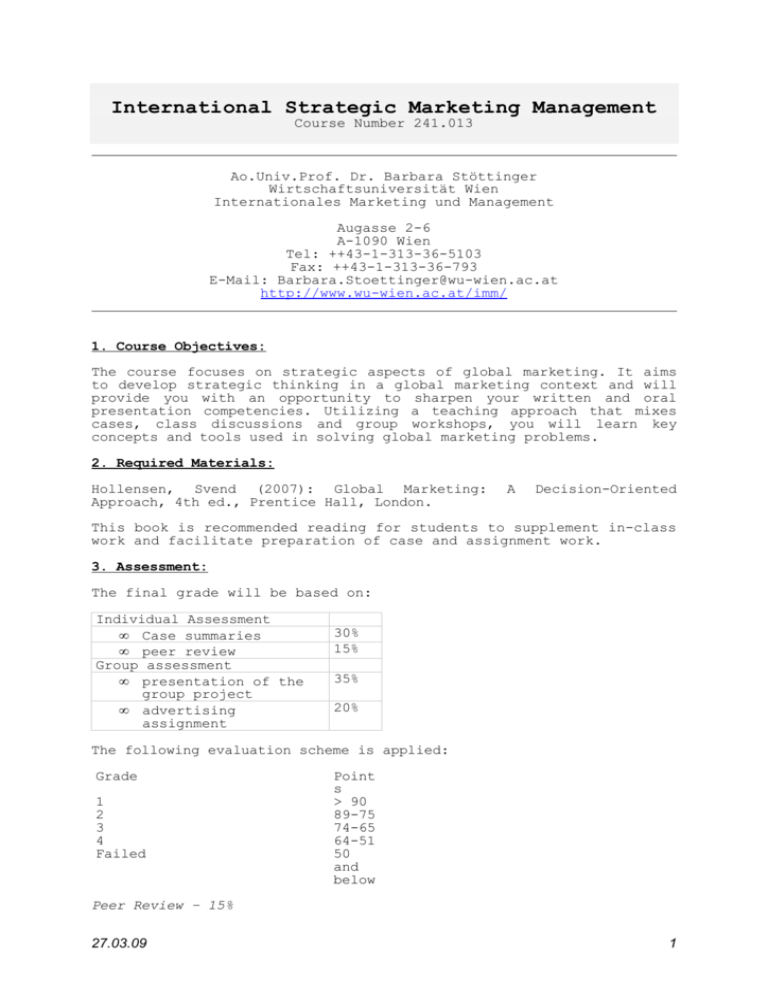
International Strategic Marketing Management Course Number 241.013 Ao.Univ.Prof. Dr. Barbara Stöttinger Wirtschaftsuniversität Wien Internationales Marketing und Management Augasse 2-6 A-1090 Wien Tel: ++43-1-313-36-5103 Fax: ++43-1-313-36-793 E-Mail: Barbara.Stoettinger@wu-wien.ac.at http://www.wu-wien.ac.at/imm/ 1. Course Objectives: The course focuses on strategic aspects of global marketing. It aims to develop strategic thinking in a global marketing context and will provide you with an opportunity to sharpen your written and oral presentation competencies. Utilizing a teaching approach that mixes cases, class discussions and group workshops, you will learn key concepts and tools used in solving global marketing problems. 2. Required Materials: Hollensen, Svend (2007): Global Marketing: Approach, 4th ed., Prentice Hall, London. A Decision-Oriented This book is recommended reading for students to supplement in-class work and facilitate preparation of case and assignment work. 3. Assessment: The final grade will be based on: Individual Assessment • Case summaries • peer review Group assessment • presentation of the group project • advertising assignment 30% 15% 35% 20% The following evaluation scheme is applied: Grade 1 2 3 4 Failed Point s > 90 89-75 74-65 64-51 50 and below Peer Review – 15% 27.03.09 1 Each team member is required to submit a peer rating form. This form is to contain an evaluation of each team member with the exception of you. The form will be kept in strict confidence. The peer rating is based on a total awardable point base of 100 points for all team members other than yourself. You should award the 100 points among your team members based on a consideration of the following: 1. Willingness of the individuals to carry out jobs assigned. 2. Ability of the individual to meet deadlines. 3. Cooperation with other team members. 4. Quality of the individual’s work. 5. Individual’s overall contribution to case reports and completion of the group project. Case Summaries - 30% Prior to the discussion of each case in class, everyone has to hand in a typed analysis of three pages (Arial 10 or larger) answering the assignment questions. PLEASE NOTE THAT ONE OF THE CASE SUMMARIES (Unilever in Brazil) IS ALREADY DUE ON THE FIRST DAY OF CLASS !! Unilever in Brazil • • • • Please carry out a PEST analysis with the case data Analyze the competition in the market Provide a customer analysis o Who are our current and potential customers? o What do they do with our products? o Where do they buy our products? o When do they buy our products? o Why do they choose our product? Why do they NOT buy our products? Identify strengths and weaknesses of Unilever in the market IKEA invades America - What factors account for the success of IKEA? What do you think of the company’s product strategy and product range? Do you agree with the matrix approach described in Figure B of the case? Despite its success, there are many downsides to shopping at IKEA: What are some of these downsides? IKEA’s Vision Statement (in Figure C of the case) describes how the company seeks to build a “ partnership ” with its customers. What do you think of this vision statement? Zara – Fast Fashion - - How well does Zara’s advantage travel globally? What do you think of Zara’s past international strategy? Evaluate, in particular, its past strategy for (product) market selection, its mode of entry, and its standardization of its marketing approach. What is the best way to grow the Zara chain? How, specifically, do you see prospects in the Italian market? And more broadly, what do you think about the strategy of focusing on Europe versus making a major commitment to a second region? 27.03.09 2 Group Project – 35% The objective of this project is to provide you with experience in developing a strategic marketing plan for introducing a product or service into a specific region. The project allows for applying the theoretical knowledge acquired in the theory sessions and practical examples on a real-life challenge. In the first session, you will be provided with brief introduction into a set of companies (where you choose one for your project). Your task for the seminar will be to select an attractive market in the CEE region for the products the company is offering and prepare a marketing plan for market entry. You are expected to utilize data resources available on the Internet, the JKU library etc. to substantiate your analysis and recommendations. You will present your analysis and recommendations at the end of the course in a plenary session. Time: 20 min presentation & 10 min Q&A for each group Further details on the project will be provided in the first session. The group project will be evaluated based on the following criteria: Content: • Thoroughness. Analysis hits on all major, relevant topics. • Focus. The key issues are identified and illuminated. • Sound argument. The content is logical and internally consistent. The audience may not necessarily agree with your conclusions and recommendations, but he/she will understand how you got there and respect your argument. • Makes the point. Summarizes findings and/or conclusion for the audience. Presentation Style • • • • • Presenters Knew the Material Presenters Made a Professional „Appearance “ Presenters Demonstrated Conviction for Their Topic Use of Visual Aids Contributed to Audience’s Understanding Team Fielded Questions Adequately Advertising Assignment – 20% Please prepare in your group company examples, where companies use a • • • global (standardized) approach to their marketing/communication activities (same products, same media message, etc.) Adapt marketing activities to the local environment Identify examples where the product/brand would not lend itself for internationalization Provide all sorts of „evidence “ for your findings (photos, videos clips, TV spots, newspaper ads, store checks) and prepare a short ppt-presentations with your findings and provide reasons, why you think the companies selected the approach they took. Further details will be discussed in the first session. 4. Instructor's Bio: 27.03.09 3 Dr. Barbara Stöttinger is Associate Professor at the Institute of International Marketing & Management and Academic Director of the Professional MBA Marketing & Sales at Wirtschaftsuniversität Wien. Prior to joining the WU, she gained industry experience as a product group manager and in consulting industrial and consumer good companies. Dr. Stöttinger has extensive experience as a lecturer and executive educator in Marketing and International Marketing, e.g., at Texas A&M University (U.S.), Aston Business School (UK), Ecole Supérieure de Commerce, Bordeaux (France), University of Ljubljana (Slovenia), the University of Economics, Prague (Czech Republic), the International MBA program (Outstanding Teaching Award, 2000, 2002, 2008) and other Professional MBA Programs at Wirtschaftsuniversität Wien. Since 2007, she has been serving as Academic Director for the Professional MBA Marketing & Sales at WU Executive Academy. Her research interests include international consumer behavior and international pricing issues. Her work has been published in leading journals such as Journal of International Marketing, Advances in International Marketing, International Business Review, Management International Review, Marketing Education Review, Psychology & Marketing, Journal of Consumer Behavior and International Marketing Review. She is also co-author of a textbook of Global Marketing Management (in German, with Warren J. Keegan and Bodo B. Schlegelmilch, Oldenbourg, Munich, 2002). 5. Schedule: Date 13 March 2009 8:30 – 11:45 HS 16 Content Introduction into the Course, Objectives and Schedule Globalization & Internationalization of Firms, Drivers & Theories The Global Marketing Environment I (Economic & Political Environment) The Global Marketing Environment II (Social & Technological Environment) Doing Business in Emerging Markets CASE: Unilever in Brazil – Part I 13 March 2009 Background Readings: 13:45 – 17:00 HS 15 • Arnold, D., Quelch, J. “ New Strategies in Emerging Markets. ” Sloan Management Review, 40, no.1 (1998): pp. 7-20 • Khanna, Tarun; Palepu, Krishna G.; Sinha, Jayant (2005). “ Strategies That Fit Emerging Markets, ” Harvard Business Review, June 2005, Vol. 83, Iss. 6, p.63-76 27.03.09 4 14 March 2009 8:30 – 11:45 HS 15 Market Assessment & Selection Global Marketing Research Segmenting, Targeting and Positioning in a Global Market Entry Modes & Decision Criteria (when to pick what) 27 March 2009 8:30 – 11:45 HS 2 Designing and Managing Global Products & Services I Background Readings: • Holt, Douglas B.; Quelch, John A., Taylor, Earl L. (2004). “ How Global Brands Compete,” Harvard Business Review, September 2004, Vol. 82, Iss. 9, p68-75. Designing and Managing Global Products & Services II CASE: IKEA invades America 27 March 2009 13:45 – 17:00 HS 15 28 March 2009 8:30 – 11:45 HS 15 3 April 2009 8:30 – 11:45 HS 16 3 April 2009 13:45 – 17:00 HS 16 4 April 2009 IKEA’s goal was to have 50 stores in operation in the United States by 2013. Already, IKEA was the fastestgrowing furniture retailer in the country. As one analyst put it, “ Not only does IKEA have monster stores and great prices, it has also created a unique niche. ” IKEA’s Mr. Dahlvig added, “ T he more stores we build and the more we increase our market share, the more we have to find ways to appeal to a broader public. ” Designing Global Marketing Communication Activities Student Presentations Global Pricing CASE: Unilever in Brazil – Part II Global Distribution CASE: ZARA – Fast Fashion Presentations – Student Projects 8:30 – 11:45 HS 15 27.03.09 5

